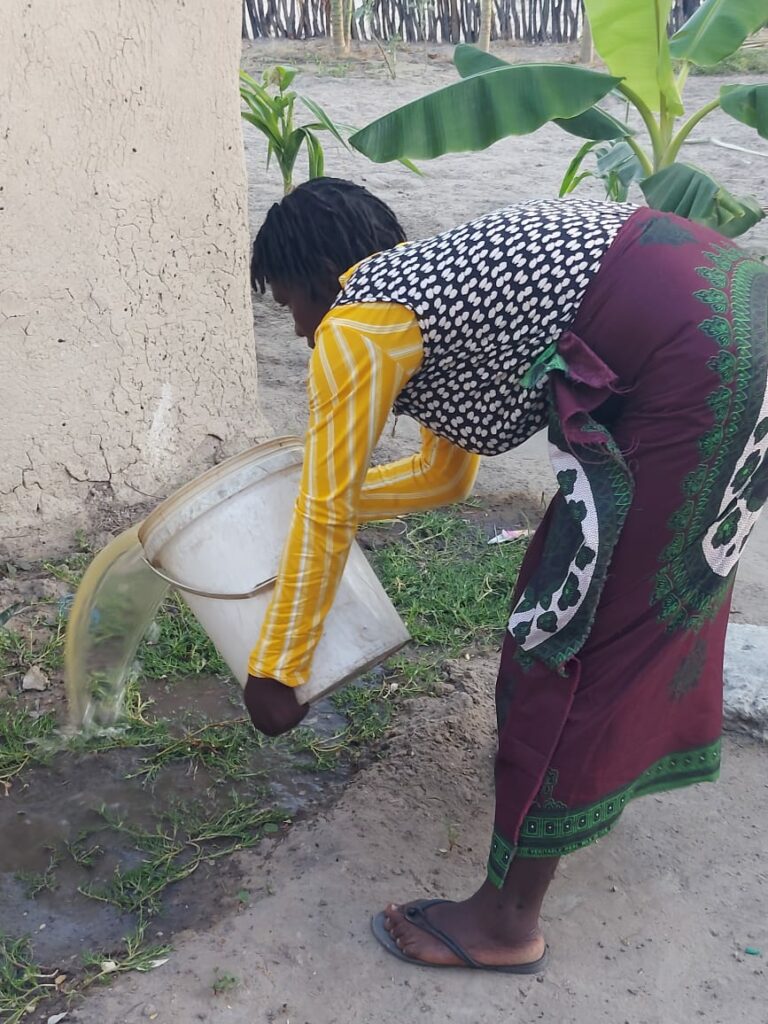The adage “water is life” is a distant aspiration for many rural communities in Namibia who are still drinking water not fit for human consumption. The sources are mostly hand-dug wells, earth dams, rivers and swamps.
Twenty five year old Precious from Sibulamunda Village in the North-Eastern Zambezi Region of Namibia knows that too well, as she has tasted water from all those sources and has never experienced the luxury of turning on a tap of clean water. For decades, her family depended on water from a neighbour’s unprotected hand-dug well where they were contributing about US$ 24 a month.
Precious and her family are excited because earlier this year they managed to drill their own eight metre deep well, thanks to her elder brother who just graduated from college and got a job as a teacher and paid for the construction. Precious’ day starts as early as five o’clock and her first point of call is the well to draw water for household use, while she also uses some of it to water the family backyard garden.
The whole community depends on water from wells and swamps without any precautionary measures, due to the absence of scientific evidence or test results for its quality and content. “This well brought us so much relief as we now don’t have to walk long distances carrying buckets on our heads. The water quality is not good but that is not a major problem because it is far better than the options we have had all our lives,” says Precious.
She expressed concern about the unhygienic nature of the unprotected wells that are usually left open, thus allowing insects, snakes or anything to fall in and pollute the water. Precious adds that it is difficult to see to the bottom of the well, it is therefore easy to drink water contaminated by the dead body of an animal or bird that can only be discovered during routine cleaning usually done every few months. “The depth of these wells which is sometimes over eight metres deep is another challenge, we always worry about the safety of people especially children who can easily fall in and get injured or die,” says Precious.
The community’s dream is to be supplied with potable water that is clean and free from germs. “We have had incidents of diarrhoea and other stomach-related ailments, but it is difficult to confidently say they are from drinking this water because it has never been tested,” she says.
Precious is of the opinion that the government should at least test the wells and boreholes in the area as well as protect them, to ensure that the water is safe for human consumption, while the water pipeline issue is being resolved.
A planned government water pipeline project, the Ngoma Water Pipeline which was aimed at giving water to more than 30,000 people over a distance of 60 kilometres could only cover about 30 kilometres and has stalled since 2014. The delays have dashed the hopes of many people who thought help was on the way. The community is blaming the government for failing to manage the project which is alleged to have been marred by mismanagement and poor workmanship. However the government is blaming the failure of the project on budgetary constraints.
Meanwhile, the Councillor for the Kabbe South Constituency, John Likando is equally concerned about the delays in the pipeline project but says the work is due to resume this year with funding through the Africa Development Fund. Likando acknowledges that the community has been given a raw deal through these challenges that led to the stalling of the project for more than nine years. “The water from most of the wells and boreholes drilled in these areas have very salty and brackish water not fit for human consumption. We are happy that the government has included the project on the priority list for this year’s capital projects,” says Likando.
The Councillor adds that the stalemate on the pipeline was a major challenge for the community and his office regarding issues of water supply and infrastructure development. “People are in desperate need of water, but we were at times hamstrung by the uncertainty of the progress on the pipeline. We could not construct more boreholes that will become redundant immediately when the pipeline is completed. In all this back and forth, it is the community that is suffering,” says Likando.
According to a report released by the World Health Organisation and the United Nations Children’s Fund (UNICEF) in 2021 through its joint monitoring programme for Water Supply, Sanitation and Hygiene, Namibia’s potable water coverage stands at 98.9% in urban areas, home to 1.3 million Namibians, and 83.2% in rural areas where the remaining 1.2 million Namibians live. The country is one of the least sparsely populated in the world and is usually referred to as the second Mongolia with an estimated 3.13 people per square kilometre.
If the Namibian government is to meet the United Nations Sustainable Development Goals of access to water for all by 2030, it has to start putting workable strategies in place because that commitment currently seems far-fetched for communities living in rural Namibia.






